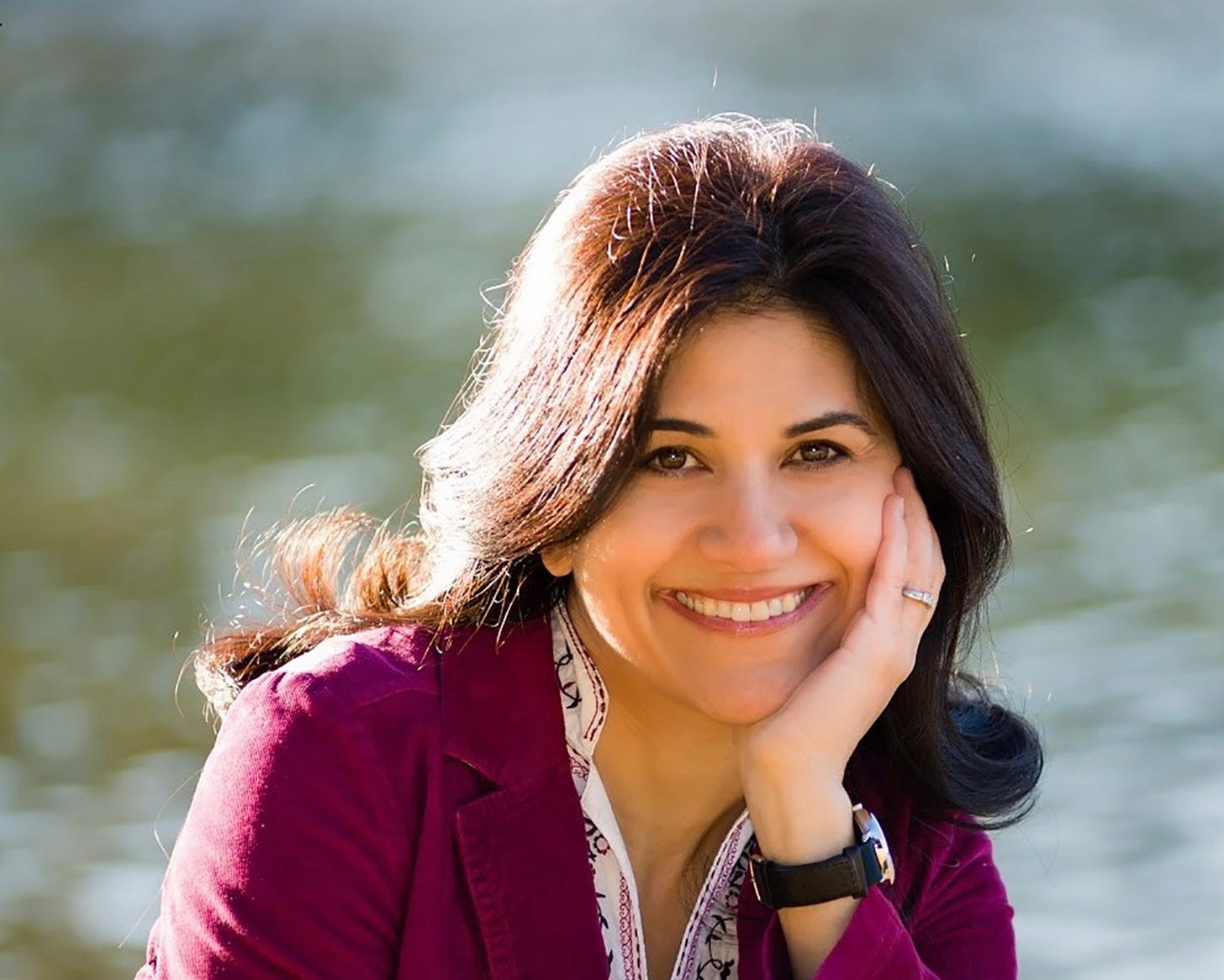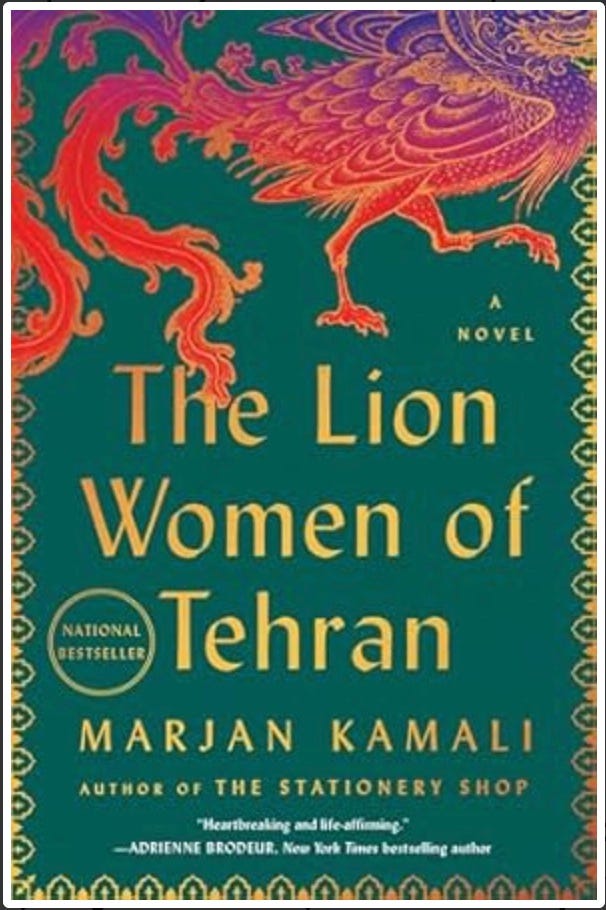When you write, you are describing the human heart with all its yearnings, regrets, pettiness, worries, joys, and triumphs. You are also examining the world and how we live in it. It is easier to know what’s in our hearts and how we navigate our world with the benefit of experience.
—Marjan Kamali
Hello friends, I’m delighted to bring you a Q and A with novelist Marjan Kamali. You may have read one of Marjan’s first two novels, Together Tea and The Stationery Shop; her most recent novel, The Lion Women of Tehran (2024) was an instant national bestseller, an Indie Next pick, a Book of the Month Club Main Selection, and is being translated into nine languages (and one of my favorites of 2024).
The Lion Women of Tehran offers the story of two Iranians, Ellie and Homa, and the friendship that begins when they’re girls in 1950s Tehran, and is tested years later by a betrayal. It’s also the story of life under the Shah’s modernizing yet dictatorial government, the seemingly sudden late-’70s revolution that unseated him, and the just-as-sudden loss of all rights for Iranian women.
Born in Turkey to Iranian parents, Marjan spent her childhood in Turkey, Iran, Germany, Kenya, and the U.S. She holds a bachelor’s degree in English literature from the University of California, Berkeley, a Master of Business Administration from Columbia University, and a Master of Fine Arts from New York University. Marjan is also a 2022 National Endowment for the Arts Literature Fellow, and she teaches at Brandeis University. She lives in the Boston area with her family.
Hi Marjan! As with so many writers, your journey to writing and publishing your first novel seems like it had a rather long, zig-zaggy trajectory. Can you tell us about that? And where were the first glimmers of fiction writing for you?
I once was told by an interviewer that in her experience writers who are women usually have many ups and downs in their trajectory, but men have a career line that is often linear and a straight vertical ascent. Well, my path was most certainly zig-zaggy! The first glimmers of fiction writing happened when I was a child in Iran. I told my mom I wanted to write a book. I was four years old and couldn’t write yet so my mom had me dictate the story as she typed it on her typewriter. She then cut and stapled the onion-skin pages together and created my first book. I still have it.
But when I arrived in New York City at the age of ten, I was encouraged to pursue a career that was stable and financially lucrative such as being a doctor, lawyer, or engineer. I did attend a science and math high school. However, I lasted only two weeks as a pre-med student in college before switching to English as my major. Later, when I applied to law schools, I mentioned in my personal statement that I wanted to be a novelist and was subsequently rejected from every law school.
There were several detours into other vocations (scientific editor, theater troupe member) until I ended up getting an MBA at Columbia University while also attending an MFA in Creative Writing program at NYU. During the day I would go uptown to do my MBA and, in the evenings, I’d go downtown to my MFA program. Talk about zig-zaggy! Later, there was an almost complete hold on writing for several years when I was a full-time stay-at-home mom. I published my first book when I was 42.
What do you know now as a writer and novelist that you wish you’d known when you first started writing?
What I know now is that it doesn’t matter if you are “first” amongst your peers to publish or to achieve any writerly milestone. What matters is that you are your best. There is no competition with others. Writing is not a race—it is a very personal journey that requires deep discipline and a mining of the self. We are all on our own timelines.
I love this, the idea of all of us being on our own timelines. We can’t hear that enough. What do you miss, if anything, about your first days of writing?
What I miss about those first days of writing is not all that much, really. There was magic in writing then but there is magic now. Back then I felt a ton of anxiety and uncertainty and while I often feel that still, I am also much more confident and secure in who I am as a person.
Can you talk about a challenge you’ve faced, in writing, publishing, or both?
I used to think that in order to write a novel, you needed ribbons of uninterrupted time. But I rarely had the luxury of having that much free time and even when I did, it was incredibly intimidating to face the page for that long. It wasn’t until I was in my thirties that I mastered writing in short blocks. You don’t need to wait for streams of unbroken time, the muse, or a retreat of any kind. I read an article in Poets and Writers magazine that recommended setting a timer for 45 minutes where you focus only on your writing (no internet, phone etc.). After the timer goes off, I get up and do something that does not involve words for the next 15 minutes. Then I might sit back down and write again or I might not. But this method (a version of the pomodoro technique https://en.wikipedia.org/wiki/Pomodoro_Technique) has made a huge difference. It has helped me write and publish three novels.
What makes a midlife writer a stronger writer?
Perspective. When you write, you are describing the human heart with all its yearnings, regrets, pettiness, worries, joys, and triumphs. You are also examining the world and how we live in it. It is easier to know what’s in our hearts and how we navigate our world with the benefit of experience. Imagine describing what a landscape looks like while at the bottom of a mountain versus describing it when you have ascended to a certain zenith and have a much better vantage point. I think midlife gives us that wider perspective that is so crucial to good writing.
“Get rid of self-manufactured deadlines and word counts and measurements. Write your heart out as you grow and learn and live. But don’t rush to be published. Life is long. As I tell my writing students: we’re not super models. We’re not going to “age out” of writing.”
What would you tell someone who’s thinking about starting to write, or someone who thinks it’s too late?
I would say to get rid of self-manufactured deadlines and word counts and measurements. Give yourself time to grow and learn and live as much as you want! That doesn’t mean you should wait to write anything at all. Write your heart out as you grow and learn and live. But don’t rush to be published. Life is long. As I tell my writing students: we’re not super models. We’re not going to “age out” of writing. In fact, many a story will only get better as we age and gain the better perspective to tell it.
Tell us about your latest novel, The Lion Women of Tehran.
The Lion Women of Tehran is a story of friendship. It’s about two girls named Ellie and Homa who come from very different stations in life but who form a fast friendship at age seven. They share the joys of childhood, ups and downs of adolescence, and go off to university together. But their friendship is ruptured when one of them betrays the other. Decades later they reconnect and reconcile in America. All along, one of them, Homa, fights tirelessly for Iranian women to be free. It takes place over the 1940s, 50s, 60s, and 70s (and then in our current time) and shows how the rights for these women expanded and grew until they were suddenly taken away.
And last, tell us about a book that you think deserves more attention.
I loved No Two Persons by Erica Bauermeister. The prose is precise and distilled. It’s a novel that beautifully explores the traumas that shape us and the power of words and story to heal us. I found it to be large-hearted, wise, and magnificent.
Previous Midlife Interview, with novelist Karen Dukess, below!
Three friendship stories
I need some quiet comfort right now, in this moment of political chaos and frightening and bizarre overreach. If you’re seeking quiet comfort, here are three short novels about friendship. Where The Lion Women of Tehran is more of a saga, spanning decades, these three novels are all fairly brief, and cover shorter timespans.
Jane and Prudence, Barbara Pym. First published in 1953, Jane and Prudence is a gentle comedy of manners. Jane Cleveland, in her early 40s, is a vicar’s wife in a small English town, and Prudence is 30, single, living in London and working for an academic. The two are friends from their Oxford years—Jane was a tutor to Prudence. Jane adjusts to life in her new parish, flails about as a vicar’s wife, and tries to matchmake for Prudence. The more glamorous Prudence, meanwhile, has been quietly in love with her oblivious (and married) boss. The novel makes gentle but pointed fun of the book’s male characters, and of that era’s gender and societal expectations. Not a whole lot happens, but if you’re looking for a visit to postwar England, Jane and Prudence might be the ticket.
For more on the wonderful, lost-and-found novelist Barbara Pym, here’s
’s illuminating post from last spring:Meet Me at the Museum, Anne Youngson. A bittersweet epistolary novel chronicling the unlikely friendship between English farmwife Tina and lonely Danish museum curator Anders. It has 84 Charing Cross Road vibes, and though it’s short, it feels well inhabited, with lots of details from both lives.
Love and Saffron, Kim Fay. Another short epistolary novel about a friendship, this one details the relationship between an older woman and a younger woman, both of them food writers in the Sixties.
If you’ve got a comforting book to recommend, please do so! (Click on the little comment bubble at the top, or the button below.)
I’ll leave you with the view from here—a vivid sunset the other night, and Otto out on the trail. As always, thank you for reading An Unfinished Story.








I particularly like her observation about not “aging out” of writing. Nor does it require anyone’s permission—except your own.
Wonderful interview. So many beautiful truths about writing.